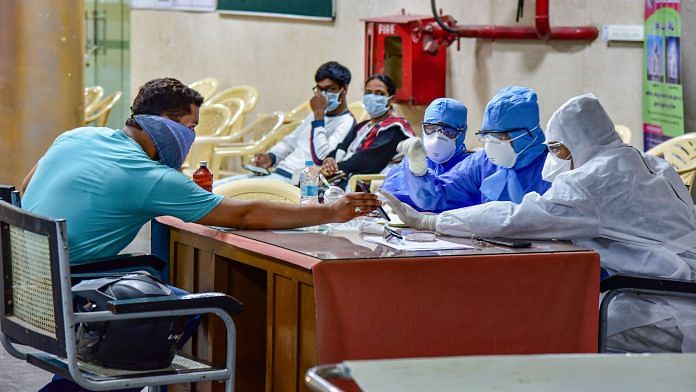New Delhi: The Indian Council of Medical Research (ICMR), the country’s apex research body, Thursday said it found no positive coronavirus cases in 826 samples taken from severely respiratory ill patients in 44 sites, suggesting no community transmission of the outbreak as of yet.
ICMR scientists, however, admitted that this cannot be taken as being fully conclusive that there is no community transmission.
“Since India is a very big country and our sampling is limited, this is the best we can do as of now,” Nivedita Gupta, scientist, epidemiology and communicable diseases cell, ICMR, told ThePrint.
“So definitely we can say that until date, there is no evidence of community transmission. But we cannot say that there is no community transmission.”
Gupta also said that testing asymptomatic patients was unnecessary at this stage. Testing asymptomatic patients during the incubation period may result in negative results due to lower viral load even if they are carrying the virus, she explained.
Also read: Is COVID-19 a biological weapon and can neem or hot bath prevent it? Fact-checking 24 claims
ICMR surveillance strategy
ICMR has been collecting 20 random samples a week of those with severe pneumonia and respiratory infection from intensive care units spread across 51 centres in India since March as part of its community surveillance. Gupta, however, said there were only 826 samples as not all centres have been able to collect 20 samples per week.
A positive case among patients above the age of 18 and if they have no travel history would mean that the virus has been spreading in the community.
Since India is in the second phase of transmission when the disease has only spread to the contacts of the laboratory-confirmed cases of COVID-19, the current testing protocols and the community surveillance are enough, Gupta said.
“The day we document a single case of community transmission, we will see another strategy for testing,” she added.
This exercise will be now part of routine surveillance and the results from the next set of samples will be known by the end of the week, she said. While all of these samples are from the government facilities there is a discussion with private sector centres to be included in the part of the surveillance, she added.
Private labs would be allowed to conduct COVID-19 tests, ICMR had said Tuesday. “We are still evolving our strategy with the private sector,” Gupta said.
ICMR is in the process of understanding and mapping the capacity of the private laboratories who are willing to participate in the process, she added.
Also read: Why healthcare workers are more at risk from COVID-19 and how hospitals are protecting them
‘Community surveillance may be missing out on other cases’
Public health experts have, however, been pointing out that relying on these results to confirm community transmission would not be wise.
“Since only 5 per cent of the COVID-19 affected patients need ICU care, we may not find enough cases through samples of ICU patients with respiratory symptoms,” said S.P. Kalantri, Director of Medicine at the Mahatma Gandhi Institute of Medical Sciences (MGIMS), Wardha, Maharashtra.
Kalantri added that the random samples should come from outpatient departments, wards and ICUs to get a real estimate.
Also as many of the sample collecting sites are in parts of the country that haven’t yet seen transmission, it would make more sense to test cases of severe community acquired pneumonia in locations around the laboratory confirmed COVID-19 cases, said Giridhar R. Babu, professor and head, Lifecourse Epidemiology, Public Health Foundation of India.
This, however, seems to have been done. “In view of the evolving nature of COVID-19 transmission, the surveillance is being expanded to include more areas specially areas where COVID-19 cases have been reported,” the ICMR’s latest press release said Thursday.
Also read: How to slow down COVID-19 — this is the only way to ‘flatten the curve’ of coronavirus spread



